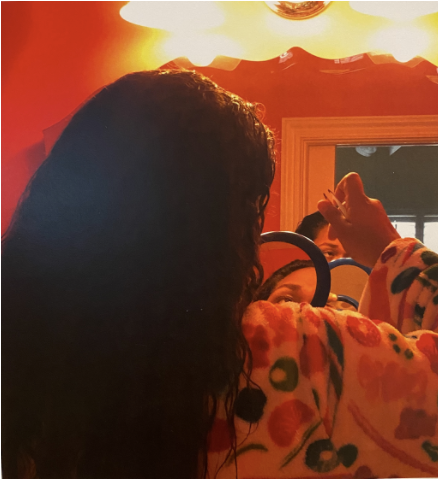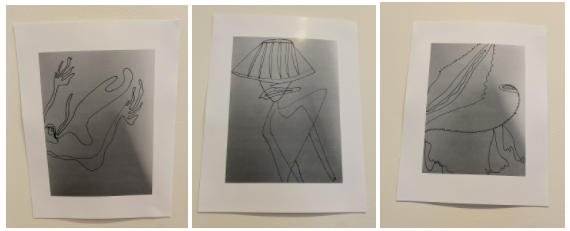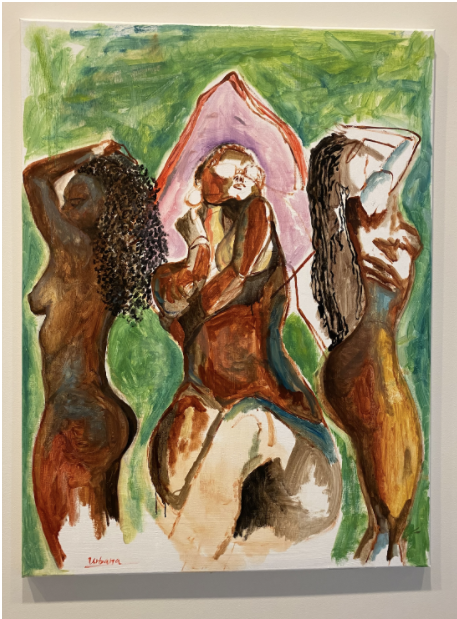
On March 12, Dorothy Poucher ’21 debuted
The Female Body: Lived and Spoken
on the second floor of the Kennedy Center for Theatre and Studio Arts. This exhibition presents Poucher’s research from her Levitt Winter Research Grant with John Stewart Kennedy Professor of Philosophy Marianne Janack and features works from Kayah Hodge ’21, Urbana Anam ’21 and Joan Masters.
The idea for this project came to Poucher last year after having numerous conversations with friends about societal perceptions of the female body. Having those conversations made Poucher realize how few opportunities and safe spaces there are for those with female bodies to have discussions about their experiences with their bodies. It also made her realize how deeply our bodies are connected to who we are and how everyone’s relationship with their body is different. According to Poucher, “One of the coolest parts of doing this project was seeing the thoughts and creative work by those around me. Joan, Kayah and Urbana’s words and work added really important elements to the subject like representation of Black and Brown bodies in art, fatphobia, social media and misogynoir, and agency. More specifically, how those perceptions affect how the world interacts with those with female bodies and how they perceive themselves.”
The exhibit is divided into three main parts: “Part 1: The Self Conscious And Constrained Body,” “Part 2: Language And Its Gaze” and “Part 3: Liberation.” Part 1 begins with a quote from author Sandra Bartky on how beauty-related advertising suggests to those with female bodies that their bodies are deficient and that they ought to take better care of themselves through strict physical and dietary regimens. This section also features quotes from Masters and Hodge in which they express how society has affected the way they view their bodies. Hodge specifically reflected on how “the definition of beauty is impacted heavily by colorism and the sexualization of the Black woman’s body. It’s “ghetto” for me to have cornrows and it’s grotesque for me to have a booty, but you will pay for one. It’s always the question of who profits off these standards.”

“Part 2: Language And Its Gaze” goes even further and explores how insulting language can be used to disempower women and those with female bodies and how they perceive their bodies. The opening quote by author Chi Luu reads, “Women are insulted through references to sexual morals or being compared to subhuman entities, while men are insulted by being associated with women and weakness/femininity.” Words like sl*t, b*tch, p*ssy, and prude target female body parts and shame those with them for behaving sexually. This part of the exhibit also asks us to reflect on our own views of sex and pleasure, where these conceptions come from, and how they reinforce expectations in our relationships with one another. For Poucher, this section of the exhibit is about “critically analyzing how the words we use further and continually re-establish agendas of misogyny and whiteness.”
In the final part of the exhibit titled “Liberation,” Poucher offers various strategies for those with female bodies to free themselves from such strong societal scrutiny of their bodies. While it is important for those with female bodies to find inner peace with their body image, Poucher cautions us to “resist the expectation that everyone around us can and should simply free themselves from the layers of oppression that systems like heteropatriarchy, colonialism, capitalism and their supporters place upon them…These outward structures must also be investigated, held accountable, and eventually reimagined.” This section also features a painting by Anam called “Black and Brown Bodies.” In her description of the painting, Anam writes, “White bodies, especially the white female body, dominate the art world. I paint Black and Brown bodies for celebration. For being a blueprint for many things without recognition. I paint Black and Brown bodies to take up space.”

Poucher’s choice to present in an artistic form with short stories, poetry, drawings and photography makes the exhibit unique. When asked why she decided to use creative mediums to express her ideas, Poucher said, “I have always felt the most moved by creative expressions of experience like poetry, art and music. While philosophy is something I’m very interested in and I think can be productive, I also feel that it can be exclusive and narrow in a way that sometimes shuts out the power of experience and emotion. It also has a history of being very white, straight and masculine, which is antithetical to the purpose of the project. So I wanted to expand what we stereotypically think of as philosophy and find a way to bridge these methods. In my head, they are all very intertwined and I think they can work together to help us understand our world and ourselves better.”
With this exhibit, Poucher hopes to spark greater dialogue around the female body and how it is perceived and understood in our society. In her words, “I hope that this collection of pieces can inspire reflection on how we treat our bodies and the bodies of others. I also hope it can help us to more critically use language when interacting with one another and the world around us.” The exhibit will be taken down this week, but an electronic copy will be made available for public viewing.














